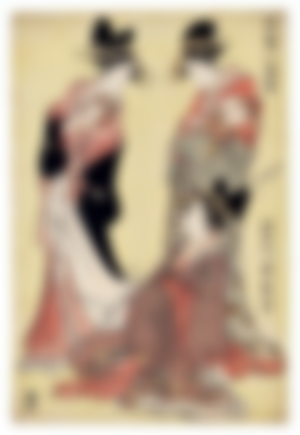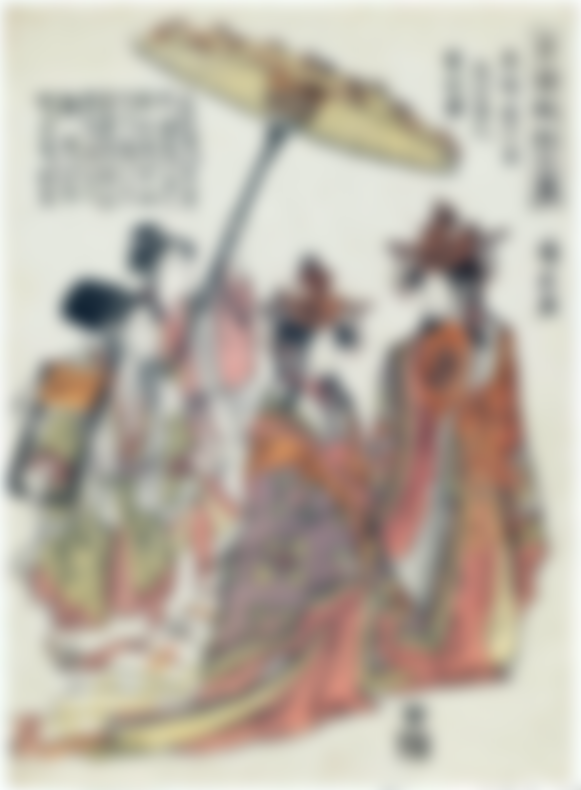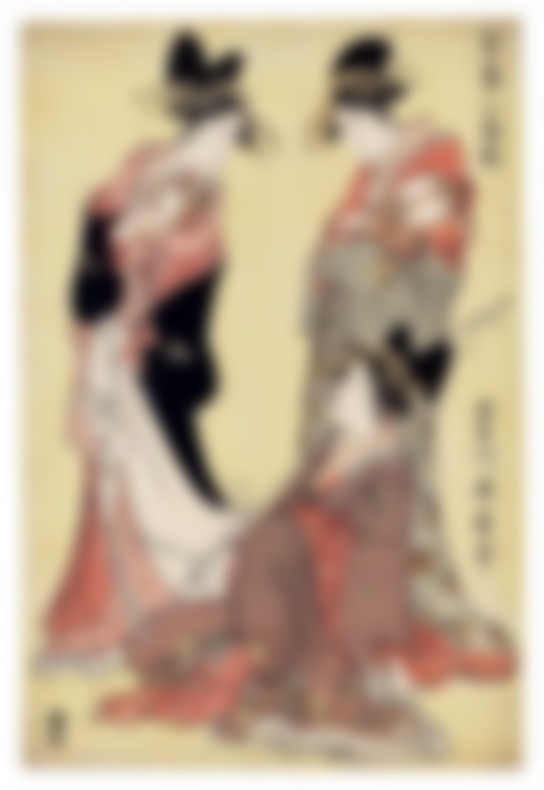Bijinga
In a previous article, I defined bijinga, pictures of beautiful women. This was one of the major subgenres of ukiyo-e, a form of secular Japanese art which evolved during the Edo period (1603-1867), and which coincides with the Tokugawa Shogunate.
From the beginning bijinga depicted courtesans from Yoshiwara, the “red light district” of Edo - later it included other women. Bijinga continued to exist as a genre even after the end of ukiyo-e, but in this article we will restrict it to bijinga within ukiyo-e, and this subgenre's three greatest masters: Harunobu, Kiyonaga and Utamaro.
By present-day standards, it can be hard for some people to see why the women of bijinga were considered to be beauties. The conventions of Japanese art differ from other aesthetic standards, particularly the western one. That's part of the adventure of discovering and exploring an alien tradition. It is necessary to learn how to see and perceive in a different way. That develops and enriches the mind of the viewer.
The human body, dressed or undressed, has been a major motive in art in most traditions (except where and when it has been forbidden for religious reasons), and it poses special challenges for the artist. Female beauty is appreciated everywhere, that is universally human.
Bijinga is also about fashion. For most of the bijinga artists, the kimono was very important. Not only to depict it beautifully, but also to design its colours and patterns. Indeed, in some prints the kimono is so important that the woman is just a pretext to show off a kimono pattern. The pictures can also be used to study other details of their appearance, for instance wooden clogs, geta - or hairstyles.
It is undeniable that many bijinga depict courtesans. They were prostitutes, but not only that. They should also be able to entertain a customer with song, music and conversation, and they came in many ranks organised according to a strict hierarchy. In their way, they were considered artists.
The prints sometimes show a courtesan with a kamuro or two. After about 1750, a kamuro is a courtesan's child attendant. Usually a girl 7-15 years old.
Some bijinga show geisha. Contrary to popular belief, a geisha was not a prostitute and is not to be confused with a courtesan. The word means artist, and a geisha was required to possess many skills. She still is, there is still a living geisha tradition in Japan, although, of course, much has changed throughout the centuries.
Geisha were also organised with many ranks according to a strict hierarchy. Surprising to many, since geisha is so strongly associated with femininity, the original geisha were men. After the middle of the 1700s, women out-performed the men and took over the whole business. Indeed, the first female geisha is said to have appeared in 1751.
Later, and especially after WWII, the term geisha came into disrepute and were increasingly associated with prostitution.
The rank of a courtesan or a geisha was reflected in her clothes or the way she arranged her hair. That, however, is a subject beyond the scope of this article.
Suzuki Harunobu (1725-1770), Torii Kiyonaga (1782-1815) and Kitagawa Utamaro (1753?-1806) are generally considered as the greatest bijinga artists, especially when it comes to nishiki-e, full-colour prints.
Harunobu
In 1765, Suzuki Harunobu made the first nishiki-e, full-colour print. Then he worked with another subgenre of ukiyo-e, e-goyomi, calendar prints, but he soon applied it to bijinga.

Harunobu did not focus on courtesans, but liked to depict ordinary girls from his own world. With the full-colour print, he also started to make a background, or at least a background colour to his figures. Earlier woodblock cut prints had been without any background colour. But, as we can se from the print above, ”Girl on a veranda”, he sometimes made elaborate backgrounds where he placed his figures in a complete environment.
The girl on this image is an elegant example of a bijin in Haronobu's style. His girls are slender and appear very young.
No doubt, Harunobu is one of the greatest innovators and pioneers within ukiyo-e. Just the development of nishiki-e might very well be the most important single technical achievement in the art of woodblock printing. Yet he was not extraordinary in the beginning of his career. His early works are good, but not excellent. It was only when a group of intellectual samurai provided financial resources that he started to experiment with technique, material, format, and style - and became the innovative master known to posterity.
Kiyonaga
As head of the Torii School, Torii Kiyonaga fused several different traditions: the style of Harunobu, the Katsukawa School and the Torii School. He was the point were all these traditions were absorbed and mixed, and from that he set the direction for how ukiyo-e subsequently evolved.
While the Torii School is best known for yakusha-e, for a long time it had nearly monopoly on kabuki posters, Kiyonaga is mainly considered a bijinga master. His style is gracefully naturalistic. A typical Kiyonaga bijin is not as young and petite as those of Harunobu, and not as tall and long-faced as those of Utamaro.
Below, we have "Court Ladies Viewing Cherry Blossoms", from 1781. Note the peculiar headgear. The kimonos also play a much more important role than they did for Harunobu.

Utamaro
The third of the great three bijinga artists is Kitagawa Utamaro, and his influence extended far beyond Japan's borders. The French impressionists gained a good part of their inspiration from him. He was also one of the very few ukiyo-e artists, who achieved fame across the whole of Japan during his lifetime.
Utamaro totally dominated bijinga during the 1790s. Some say that he influenced bijinga as much as Sharaku influenced yakusha-e. He was interested not only in depicting the beautiful courtesans themselves, but also scenes from their and other women's lives. In addition to that, he made images of insects, shunga, and a lot of other motives.
In 1804, he published pictures from a banned novel, "Hideyoshi and his five concubines". Hideyoshi was a military dictator in the 1500s and Utamaro was accused of insulting Hideyoshi's honour. There are different opinions on what his penalty was. Some sources say he received a short prison sentence, others that he was sentenced to be handcuffed for 50 days. Whatever was the case, the incident broke him emotionally and it basically finished him as an artist. He died in 1806.
This is from a Yoshiwara Triptych (Seirô sanpukutsui), 1793.

My Personal Bijinga Favourites
Among my personal bijinga favourites, we find Harunobu's Girl on a Veranda, the first image of this article.
Another is The Heron Maiden by Koryusai, a grossly underestimated artist.
My third choice is Courtesan Standing in Front of a Building by Toyonobu, a less known artist, who is not all that interesting in general, but I still like this particular bijinga, although it is not a nishiki-e, a full colour print.
(This article is based on material previously published in Meriondho Leo.)
Copyright © 2020 Meleonymica/Mictorrani. All Rights Reserved.
You find all my articles on Japanese Art & Culture here.
Interested in Japanese culture? Join my community Japanese Art & Cultural History (7c1f).
You find all my writings on Read.Cash, sorted by topic, here.



There really is a certain art style the japanese adapted in that era. It's fascinating that the outcome is so detailed despite the simplicity of the style itself. But i still find it so hard to distinguish who made which compared to the styles in the west